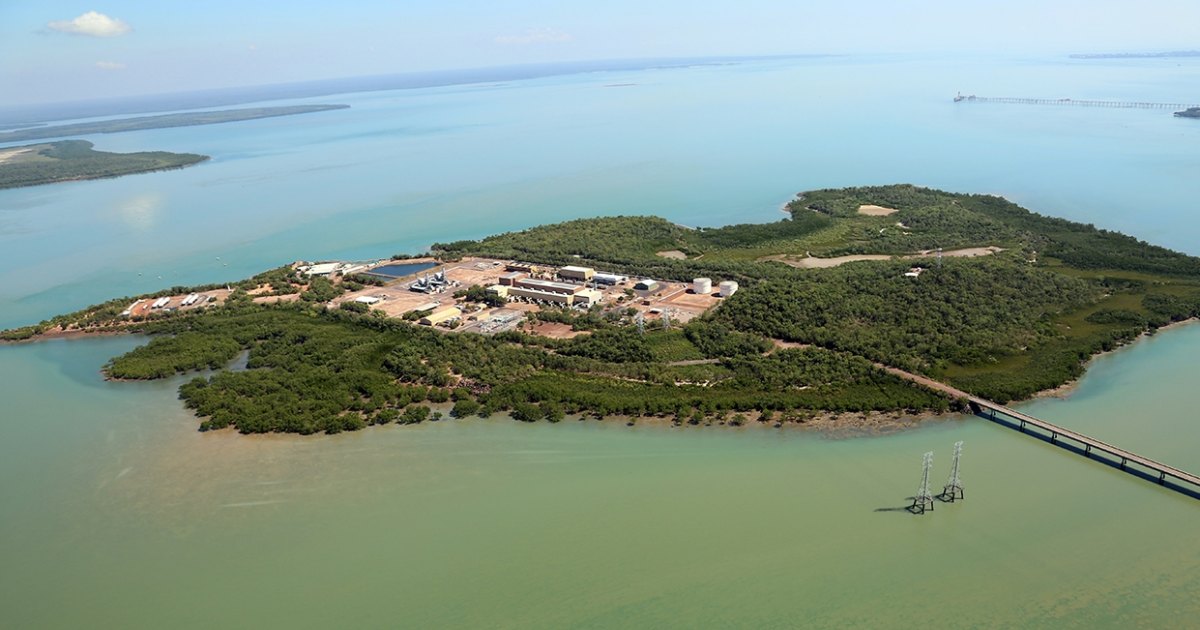
Darwin’s Channel Island Power Station | Image source: Territory Generation
An important construction milestone has been reached for the Northern Territory’s Darwin-Katherine Battery Energy Storage System (DK BESS) project.
The DK BESS is a 34.7MW/34.7MWh (primarily noted as 35MVA) project being constructed in the south-eastern area of Channel Island Power Station (CIPS – pictured above) in Darwin.
A 279 MW gas-fired facility with diesel backup capability, CIPS is currently the main source of electricity for the Darwin-Katherine Interconnected system, which provides power to 150,000 Territorians. The first generation units were commissioned at CIPS in 1986.
The $45 million DK BESS is being implemented to reduce the need for gas-fired spinning reserve and increase stability and reliability of power supply within the Darwin-Katherine system. It will soak up solar energy generated during the day and deliver important grid services; including managing fluctuations resulting from the intermittent nature of solar power.
The BESS will also unlock further capacity for commercial and home solar power in the Northern Territory; specifically within the Darwin-Katherine Interconnected system.
Darwin’s “big battery” is expected to deliver annual cost savings of around $9.8 million – so, around 4.6 years simple payback – and emissions reductions of approximately 58,000 tonnes per annum.
A tender was awarded for the DK BESS to Hitachi Energy in December last year. The NT Government announced yesterday civil and building works are now complete, and Hitachi Energy has mobilised to carry out the next phase of construction.
“The Battery Energy Storage System will reinforce the Northern Territory as the solar capital of Australia. It will store power and be the backbone of the Darwin to Katherine Electricity grid,” said NT Chief Minister, Natasha Fyles. “The Territory Labor Government is backing Territorians, solar and lower prices to get it done.”
Northern Territory Minister for Renewables and Energy Selena Uibo said construction of the Darwin-Katherine BESS is a ” huge step forward” in the NT Government’s plan for 50% renewables by 2030.
“Our electricity will be more reliable and stable, whilst maintaining affordability for Territorians which is what they expect and deserve.”
The Darwin-Katherine Battery Energy Storage System is expected to be fully operational in the second half of next year.
DK BESS To Boast Virtual Synchronous Machine Tech
Hitachi Energy is deploying its Virtual Synchronous Machine (VSM) solution as the key technology for the project. Hitachi describes VSM as tech that:
” strengthens the grid by replicating the behavior and performance of a synchronous machine, providing virtual inertia, high fault current injection, seamless islanding and other services.”
Commenting on the DK BESS project, Hitachi Energy Country Managing Director Bernard Norton said:
“This is a bold step towards operating the entire Darwin Katherine network without gas powered generators.”
Hitachi/ABB’s VSM tech is already in use in other big battery systems, including at the Energy Storage for Commercial Renewable Integration (ESCRI) project at Dalrymple in South Australia. ESCRI is a 30 MW/8 MWh system that was the first grid forming BESS installed in Australia’s National Electricity Market (NEM).

 RSS - Posts
RSS - Posts



Where are all the promised cheaper (BESS) batteries?
34.7MW/34.7MWh at $45 million in 2022.
Cost seem to have risen since 2017
100MW/129MWh at $89million for the Tesla big battery (Hornsdale).
There has been little inflation until recently and AU/US$ was 0.67 is now 0.68.
Dave,
“Where are all the promised cheaper (BESS) batteries?”
Oil price is the leading cause of inflation.
https://twitter.com/aeberman12/status/1557383965392134146
Diesel fuel is the workhorse of the global economy.
Rising fuel prices, particularly diesel fuel prices, increase the cost of mineral extraction, transporting materials/goods and services, and as a result worsen inflation by raising the end price that customers have to pay for all goods.
Global gasoil & diesel fuel production has been in a steady decline, from a peak of around 26 Mb/d in 2015-2018, to below 23 Mb/d by mid-2021.
https://crashoil.blogspot.com/2021/11/el-pico-del-diesel-edicion-de-2021.html
I’d suggest unless diesel fuel prices fall, or diesel fuel dependency reduces, then battery prices will likely stay higher.